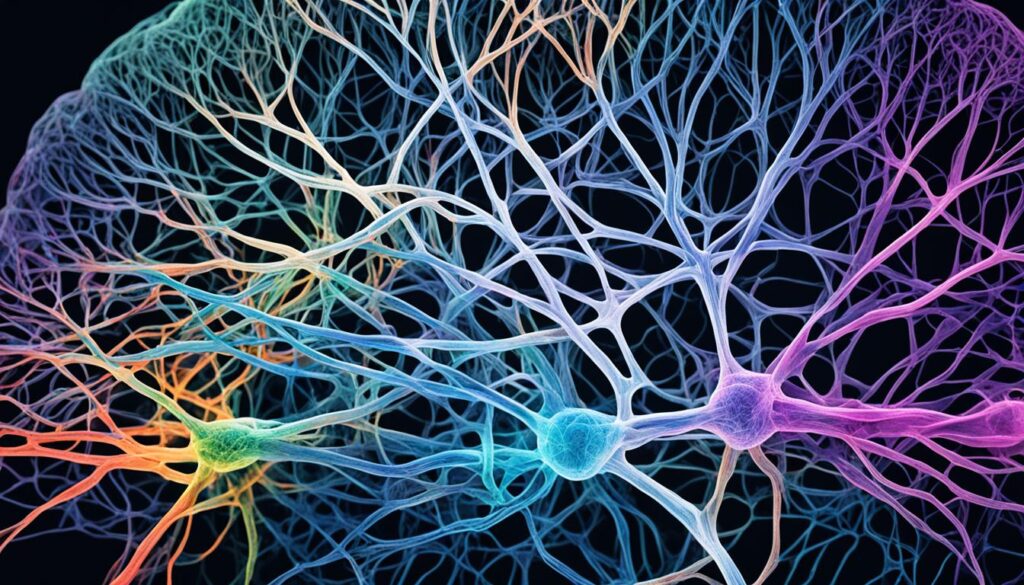Borderline Personality
Understanding the Causes of BPD Explained

Did you know that about 1.6% of adults in the United States are affected by borderline personality disorder (BPD)? This substantial number highlights the complexity of this mental health problem and stresses the need for a deeper understanding of its causes and risk factors.
BPD is not a condition with a simple origin. It is influenced by a combination of genetic, environmental, and psychological factors. Genetic factors play a role, as there is evidence that BPD can run in families. Additionally, abnormalities in brain chemicals and structures have been observed in individuals with BPD. Environmental factors, such as childhood trauma and unstable relationships, can also contribute to the development of BPD.
In this article, we will delve into the various causes of BPD, exploring genetic, environmental, neurobiological, psychological, and developmental factors. By gaining a comprehensive understanding of these underlying causes, we can better identify and treat BPD, providing hope and support to those affected.
Key Takeaways:
- BPD is a complex condition influenced by genetic, environmental, and psychological factors.
- Genetic factors play a role in predisposing individuals to BPD.
- Abnormalities in brain structure and chemicals may contribute to BPD symptoms.
- Environmental factors, such as childhood trauma, can increase the risk of developing BPD.
- Understanding the causes of BPD is crucial for accurate diagnosis and effective treatment.
Genetic Factors in BPD
When it comes to understanding the causes of borderline personality disorder (BPD), genetic factors have shown to play a significant role. Research has revealed that individuals with a family history of BPD or other mental health disorders are at an increased risk of developing the condition themselves. While specific genes associated with BPD have not been identified, it is believed that a combination of genetic variations contributes to the vulnerability of developing the disorder.
Essentially, genetic factors create a predisposition to BPD, making certain individuals more susceptible to developing the disorder. These genetic variations may influence the way the brain processes and regulates emotions, contributing to the characteristic symptoms of BPD.
The Role of Family History
Family history plays a crucial role in understanding the genetic causes of BPD. Studies have observed that individuals with parents or siblings diagnosed with BPD are more likely to develop the disorder themselves. This indicates that there may be a hereditary component to BPD, where certain genetic traits increase the risk of developing the condition.
Genetic factors create a predisposition to BPD, making certain individuals more susceptible to developing the disorder.
Complex Genetic Interactions
While the exact genes responsible for BPD have not been pinpointed, it is believed that multiple genetic variations interact with each other to contribute to the development of the disorder. These genetic interactions may affect the functioning of neurotransmitters, such as serotonin, which play a crucial role in regulating emotions and mood.
A better understanding of the genetic causes of BPD holds promise for improved diagnosis, treatment, and prevention strategies. By identifying specific genetic markers associated with the disorder, researchers can develop targeted interventions that address the underlying biological mechanisms.
| Genetic Factors in BPD | Risk Factors |
|---|---|
| Family history of BPD | Increased likelihood of developing the disorder |
| Genetic variations | Predisposition to BPD |
| Complex interactions | Affecting neurotransmitter functioning |
Environmental Factors in BPD
Environmental influences play a significant role in the development of borderline personality disorder (BPD). Particularly, childhood experiences can shape an individual’s vulnerability to the condition. Various risk factors are associated with BPD, including:
- Emotional, physical, or sexual abuse during childhood
- Long-term fear or distress experienced during childhood
- Neglect or deprivation of emotional needs
- Growing up in a household with a family member with a serious mental health condition or substance abuse problem
- Unstable or invalidating relationships
These environmental factors can contribute to the development of BPD by impacting a person’s emotional and psychological well-being. Childhood trauma, such as abuse or neglect, can shape an individual’s attachment style and ability to regulate emotions. Additionally, growing up in an unstable or invalidating environment can create a foundation for difficulties in interpersonal relationships and emotional stability.

“Our upbringing and the environment we grow up in can have a profound impact on our mental well-being. For individuals with BPD, adverse childhood experiences and unstable relationships can significantly contribute to the development of the disorder.”
Understanding and addressing the environmental factors that contribute to BPD is crucial for effective diagnosis and treatment. A comprehensive approach that encompasses psychotherapy, such as Dialectical Behavior Therapy (DBT), can help individuals with BPD develop healthier coping mechanisms and improve their emotional regulation skills.
Neurobiological Factors in BPD
Neurobiological factors play a significant role in understanding borderline personality disorder (BPD). Research has shown that individuals with BPD exhibit abnormalities in brain structure and function, which contribute to the emotional dysregulation and impulsivity commonly seen in this condition.

MRI scans have provided valuable insights into the neurobiology of BPD. These scans have revealed that specific brain regions, such as the amygdala, hippocampus, and orbitofrontal cortex, may be smaller or exhibit abnormal activity in individuals with BPD. These findings suggest that structural and functional differences in these brain areas contribute to the symptoms and behaviors associated with BPD.
The amygdala, known for its role in processing emotions, has been found to be hyperactive in individuals with BPD. This hyperactivity may contribute to the intense emotional reactions and emotional dysregulation experienced by individuals with the disorder.
The hippocampus, which plays a crucial role in memory and emotions, has also been implicated in BPD. Research suggests that individuals with BPD have smaller hippocampal volumes, potentially affecting their ability to regulate emotions and memories.
Further, the orbitofrontal cortex, responsible for decision-making and impulse control, seems to show abnormalities in individuals with BPD. These abnormalities may contribute to the impulsive and self-destructive behaviors often observed in this population.
Overall, the neurobiological factors in BPD provide valuable insights into the origins and mechanisms of the disorder. The abnormalities observed in brain structure and function highlight the complex interplay between biology and behavior in individuals with BPD.
Neurobiological Factors in BPD: Key Findings
| Brain Region | Abnormalities Observed |
|---|---|
| Amygdala | Hyperactivity, contributing to emotional dysregulation |
| Hippocampus | Smaller volumes, affecting emotion regulation and memory |
| Orbitofrontal Cortex | Abnormalities in decision-making and impulse control |
Psychological Factors in BPD
When it comes to understanding the causes of borderline personality disorder (BPD), psychological factors play a significant role. An individual’s early upbringing and attachment style can greatly contribute to the development of BPD.
Difficulties in emotion regulation and coping skills can increase the risk of developing BPD. These individuals may struggle to effectively manage and cope with intense emotions, leading to emotional dysregulation and instability.
Furthermore, individuals with BPD often have a negative self-image. They may struggle with low self-esteem, feelings of worthlessness, and a sense of being fundamentally flawed. These negative self-perceptions can fuel the emotional turbulence experienced in BPD.
Moreover, individuals with BPD may exhibit a heightened sensitivity to perceived rejection or abandonment. This sensitivity can trigger intense fear and anxiety, making it challenging for them to establish and maintain stable relationships.
“An individual’s early upbringing and attachment style can greatly contribute to the development of BPD.”
Understanding these psychological factors is crucial for effectively addressing and treating BPD. With the right therapeutic interventions and support, individuals with BPD can develop healthier coping mechanisms, improve their self-image, and enhance their interpersonal relationships.

| Psychological Factors | Risk Factors for BPD |
|---|---|
| Difficulties in emotion regulation and coping skills | Increases the risk of developing BPD |
| Negative self-image | Contributes to emotional dysregulation in BPD |
| Heightened sensitivity to perceived rejection or abandonment | Creates challenges in establishing and maintaining stable relationships |
Developmental Factors in BPD
When it comes to the development of borderline personality disorder (BPD), it’s important to consider the role that developmental factors play. Early attachment disruptions and difficulties in emotional and social development can have a significant impact on the development of BPD.
Individuals who have experienced trauma, neglect, or inconsistent caregiving during their formative years may have a distorted perception of themselves and others. These early developmental experiences shape their ability to regulate emotions, form and maintain healthy interpersonal relationships, and establish a stable self-identity.
Children who have experienced trauma, such as physical or emotional abuse, are at a higher risk of developing BPD later in life. Additionally, growing up in an environment where a family member has a serious mental health condition or substance abuse problem can also contribute to the development of BPD.
These developmental factors can have a lasting impact on individuals, influencing their emotional well-being and interpersonal interactions. Understanding and addressing these factors are crucial in providing effective support and treatment for individuals with BPD.
The Impact of Developmental Factors in BPD
Developmental factors can impact various aspects of an individual’s life, contributing to the symptoms of BPD. Here are some key areas affected by developmental factors:
- Emotion Regulation: Individuals with a history of developmental disruptions may struggle with regulating their emotions effectively. They may experience intense mood swings and have difficulty managing stress and frustration.
- Interpersonal Relationships: Difficulties in forming and maintaining stable relationships are common among individuals with BPD. Trust issues, fear of abandonment, and challenges in communication and conflict resolution often arise due to developmental factors.
- Self-Identity: Individuals with BPD may have an unstable sense of self, frequently shifting their self-perception based on external validation or criticism. A negative self-image and feelings of emptiness are common.
By examining and addressing these developmental factors, mental health professionals can provide targeted interventions to help individuals with BPD overcome these challenges and lead more fulfilling lives.
“Our early experiences shape the way we see ourselves and others. Addressing developmental factors in BPD treatment allows us to provide comprehensive support and help individuals heal from past wounds.” – Dr. Jane Thompson, Clinical Psychologist

| Developmental Factors | Impact on BPD |
|---|---|
| Early attachment disruptions | Distorted self-perception and difficulties in forming trusting relationships |
| Emotional and social development challenges | Difficulties in regulating emotions and managing interpersonal interactions |
| History of trauma and neglect | Increased risk of developing BPD and heightened emotional dysregulation |
| Family environment with mental health issues | Higher likelihood of developing BPD and challenges in maintaining stable relationships |
Understanding the developmental factors involved in BPD empowers us to provide more targeted support and interventions. By addressing these factors in therapeutic settings, individuals with BPD can work towards healing, growth, and improved well-being.
Understanding Borderline Personality Disorder
Borderline personality disorder (BPD) is a mental illness characterized by difficulties in regulating emotions and unstable relationships. It affects millions of individuals worldwide, and understanding its symptoms and signs is crucial for recognizing and seeking appropriate help.
What is Borderline Personality Disorder?
Borderline personality disorder is a complex condition that affects a person’s thoughts, emotions, and behaviors, making it challenging to maintain stable relationships and navigate daily life. People with BPD often experience intense mood swings, with emotional highs and lows that can change rapidly. They may struggle with a distorted self-image, constantly feeling unsure of who they are or what they want in life.
This mental health condition is deeply distressing and can lead individuals to engage in impulsive behaviors, such as reckless spending, substance abuse, or engaging in self-harm. Additionally, people with BPD may have difficulties managing anger and expressing their emotions in healthy ways. They may also experience a persistent fear of abandonment, leading to intense and often unstable relationships.
Symptoms and Signs of BPD
While the symptoms of borderline personality disorder can vary from person to person, several common signs indicate its presence. These include:
- Intense and rapidly fluctuating emotions
- Feelings of emptiness and intense loneliness
- Impulsive and risky behaviors, such as self-harm, substance abuse, or reckless driving
- Unstable self-image and sense of self
- Frequent and intense mood swings
- Chronic feelings of worthlessness or inadequacy
- Difficulty maintaining stable relationships
- Intense fear of abandonment
It is essential to remember that these symptoms can vary in severity and may overlap with other mental health conditions. A professional diagnosis is necessary for proper identification and treatment.
Seeking Help and Treatment
If you or someone you know is experiencing the symptoms mentioned, it is crucial to seek professional help. A mental health professional, such as a psychiatrist or psychologist, can conduct a comprehensive assessment and make an accurate diagnosis.
Treatment for borderline personality disorder often involves a combination of psychotherapy and, in some cases, medication. Psychotherapy, especially Dialectical Behavior Therapy (DBT), can help individuals learn coping mechanisms, regulate emotions, and improve relationships. Medications may be prescribed to manage specific symptoms or any co-occurring mental health conditions.

With early intervention and appropriate treatment, individuals with borderline personality disorder can lead fulfilling lives and experience significant improvements in their overall well-being.
Diagnosis and Treatment of BPD
Diagnosing borderline personality disorder (BPD) requires the expertise of a licensed mental health professional who conducts a comprehensive assessment of symptoms and an in-depth interview. This thorough evaluation helps to accurately identify BPD and rule out other conditions with similar symptoms. It is important for individuals with concerns about BPD to seek professional help for an accurate diagnosis.
The primary approach to treating BPD is psychotherapy, which can provide individuals with the necessary tools and skills to manage their symptoms effectively. Two commonly used therapies for BPD are Dialectical Behavior Therapy (DBT) and Cognitive Behavioral Therapy (CBT).
1. Dialectical Behavior Therapy (DBT)
DBT is a specialized form of therapy that focuses on assisting individuals with BPD in developing strategies to regulate their emotions, manage impulsive behaviors, and improve communication and relationships. Through a combination of individual therapy, group skills training, phone coaching, and therapist consultation, DBT fosters a supportive environment for individuals to learn and practice healthy coping mechanisms.
2. Cognitive Behavioral Therapy (CBT)
Cognitive Behavioral Therapy (CBT) is another evidence-based therapy that is effective in treating BPD. CBT helps individuals identify and change negative thought patterns and behaviors, enabling them to develop healthier perspectives and improve emotional regulation. By challenging negative beliefs and promoting adaptive coping strategies, CBT can help individuals enhance their overall well-being.
In addition to psychotherapy, medications may be prescribed to manage specific symptoms associated with BPD or any co-occurring mental health conditions that individuals may experience. Antidepressants, mood stabilizers, and antipsychotic medications can be used in conjunction with therapy to help individuals achieve symptom relief.

It is crucial for individuals with BPD to seek treatment from properly trained professionals specializing in the diagnosis and management of the disorder. Ongoing support and regular therapy sessions are essential for individuals with BPD to effectively manage their symptoms and work towards a healthier life.
| Treatment Approaches | Description |
|---|---|
| Dialectical Behavior Therapy (DBT) | Specialized therapy that helps individuals with BPD regulate emotions, manage impulsive behaviors, and improve relationships. |
| Cognitive Behavioral Therapy (CBT) | Therapy that focuses on identifying and changing negative thought patterns and behaviors, promoting healthier perspectives and emotional regulation. |
| Medications | Prescribed to manage specific symptoms or co-occurring mental health conditions, such as antidepressants, mood stabilizers, and antipsychotic medications. |
Conclusion
Borderline personality disorder (BPD) is a complex condition influenced by various causes, including genetic, environmental, and psychological factors. Genetic predisposition plays a role in BPD, with evidence suggesting that the condition can run in families. Abnormalities in brain structure and chemicals, such as serotonin, can contribute to the symptoms of BPD. Environmental factors, like childhood trauma and unstable relationships, also increase the risk of developing BPD.
Understanding the causes of BPD is crucial for effective diagnosis and treatment. Psychotherapy, particularly Dialectical Behavior Therapy (DBT) and Cognitive Behavioral Therapy (CBT), is the primary approach for managing BPD. These therapies help individuals develop healthier coping strategies and improve their emotional regulation. In some cases, medications may be prescribed to manage specific symptoms or co-occurring mental health conditions.
With appropriate treatment and support, individuals with BPD can lead fulfilling lives. It is important for those affected by BPD to seek help from trained professionals and engage in ongoing therapy. By addressing the underlying causes and learning effective strategies for managing symptoms, individuals with BPD can experience improved well-being and develop healthier relationships.
Borderline personality disorder (BPD) is believed to be influenced by a combination of genetic, environmental, and psychological factors. Genetic factors, such as a family history of BPD or other mental health disorders, can increase the risk of developing BPD. Environmental factors, including childhood trauma and growing up in a household with a family member with mental health issues, also contribute to the development of BPD. Psychological factors, such as difficulties in emotion regulation and negative self-image, can also play a role in the development of BPD. Yes, research suggests that genetics play a role in the development of BPD. Individuals with a family history of BPD or other mental health disorders may have a higher risk of developing the condition themselves. Specific genes have not been identified, but it is believed that a combination of genetic variations contributes to the vulnerability to developing BPD.
Environmental factors, particularly childhood experiences, can contribute to the development of BPD. Individuals who have experienced emotional, physical, or sexual abuse, as well as long-term fear or distress during childhood, are more likely to develop BPD. Growing up in a household with a family member with a serious mental health condition or substance abuse problem, neglect, and unstable or invalidating relationships can also increase the risk of developing BPD.
Yes, neurobiological factors have been observed in individuals with BPD. MRI scans have shown that certain parts of the brain, such as the amygdala, hippocampus, and orbitofrontal cortex, may be smaller or have abnormal activity in individuals with BPD. These brain abnormalities may contribute to the emotional dysregulation and impulsivity seen in individuals with BPD.
Psychological factors, including an individual’s early upbringing and attachment style, can contribute to the development of BPD. Difficulties in emotion regulation and coping skills, as well as a negative self-image, may increase the risk of developing BPD. Additionally, individuals with BPD may have a heightened sensitivity to perceived rejection or abandonment, leading to intense fear and difficulty in maintaining stable relationships.
Developmental factors, such as disruptions in early attachment and difficulties in emotional and social development, may contribute to the development of BPD. Early experiences of trauma, neglect, or inconsistent caregiving can shape the way individuals with BPD perceive themselves and others. These developmental factors can impact emotion regulation, interpersonal relationships, and self-identity, contributing to the symptoms of BPD. Borderline personality disorder is a mental illness characterized by difficulties in regulating emotions and unstable relationships. Individuals with BPD may experience intense mood swings, have a distorted self-image, exhibit impulsive behavior, engage in self-harm or suicidal behaviors, and struggle with intense and unstable relationships. Symptoms of BPD can vary in severity and may be influenced by genetic, environmental, and psychological factors.
BPD is typically diagnosed by a licensed mental health professional through a thorough interview and assessment of symptoms. Psychotherapy, particularly Dialectical Behavior Therapy (DBT) and Cognitive Behavioral Therapy (CBT), is the primary treatment approach for BPD. Medications may be prescribed to manage specific symptoms or co-occurring mental health conditions. It is important for individuals with BPD to seek treatment from appropriately trained professionals and to receive ongoing support.
FAQ
What are the causes of borderline personality disorder?
Are there genetic factors involved in BPD?
What are some environmental factors that contribute to BPD?
Are there neurobiological factors involved in BPD?
What psychological factors contribute to the development of BPD?
How do developmental factors contribute to BPD?
What is borderline personality disorder?
How is BPD diagnosed and treated?
Paul is a storyteller at heart, sharing narratives illuminating the lived experiences of those with BPD. His work encompasses a range of topics, from personal journeys to the challenges and triumphs faced by individuals navigating life with BPD. Paul’s authentic and engaging writing style invites readers into the world of BPD, promoting awareness and empathy.
Borderline Personality
Borderline Personality Disorder Promiscuity
Beneath the surface of Borderline Personality Disorder lies a complex relationship with promiscuity, inviting a deeper exploration into the intertwined realms of emotion and behavior.

Exploring the intricate connection between Borderline Personality Disorder (BPD) and promiscuity, it becomes essential to reflect upon the underlying causes of such behaviors.
The correlation between BPD and promiscuity goes beyond surface-level observations, delving into a realm where emotions, impulsivity, and coping mechanisms intertwine.
Let's unravel the complexities surrounding this phenomenon to shed light on the nuanced relationship between BPD and promiscuity, offering insights that may challenge preconceived notions and spark further contemplation on the subject.
Key Takeaways
- Promiscuity in BPD can stem from intense emotional turmoil.
- Trust issues and instability in relationships are common consequences.
- Developing coping strategies and seeking therapy are essential.
- Combating stigma and offering support can aid in recovery.
Understanding Borderline Personality Disorder
In understanding Borderline Personality Disorder, one can't overlook the complexity of the emotional turmoil individuals with BPD experience. People with BPD often grapple with intense emotions and impulsivity, which can manifest in reckless behaviors like promiscuity.
Sexual behavior in BPD individuals may serve as a coping mechanism, a way to express their overwhelming emotions or seek validation. This impulsivity and emotional intensity can lead to difficulties in managing relationships and personal well-being.
Seeking professional help is essential for those with BPD to address these challenges effectively. Therapists can assist in developing coping strategies tailored to the individual's needs, helping them navigate their emotional landscape and reduce impulsive behaviors.
Impact of Promiscuity on Relationships

Understanding the impact of promiscuity on relationships for individuals with borderline personality disorder reveals the intricate challenges they face in establishing and maintaining emotional connections.
High levels of promiscuity in BPD can lead to emotional turmoil and conflicts within intimate relationships. Trust issues often arise due to the impulsive behavior associated with promiscuity, hindering the development of deep emotional intimacy with partners.
The cycle of unstable relationships caused by promiscuous behavior contributes to ongoing emotional distress for individuals with BPD. This maladaptive coping mechanism further complicates the ability to form healthy and lasting relationships.
The struggle to balance the desire for intimacy with the impulsivity of promiscuity can create significant barriers to establishing trust and stability in relationships. Individuals with BPD may find themselves caught in a pattern of seeking temporary connections as a way to manage their emotional needs, ultimately impacting their ability to cultivate meaningful and fulfilling relationships.
Coping Mechanisms for Promiscuous Behaviors
Exploring effective strategies to address and manage promiscuous behaviors in individuals with Borderline Personality Disorder reveals valuable insights into fostering healthier coping mechanisms. When dealing with promiscuity in BPD, it's crucial to consider the emotional responses and underlying triggers that contribute to this behavior.
Here are some key coping mechanisms to help individuals navigate promiscuous behaviors:
- Develop self-soothing techniques: Creating healthy ways to soothe oneself can help manage the intense emotions that may drive promiscuous behaviors.
- Make selective partner choices: Choosing partners based on respect and mutual understanding can promote healthier relationships and reduce impulsive behavior.
- Seek validation through internal sources: Encouraging self-worth from within rather than seeking external validation can decrease the reliance on multiple partners for validation.
- Address fear of abandonment: Working with a therapist to confront and manage the fear of abandonment can lead to more stable and fulfilling relationships.
- Enhance emotional stability: Learning to regulate emotions effectively can contribute to a sense of stability and reduce the urge for risky behaviors like promiscuity.
Therapeutic Approaches for BPD and Promiscuity

Navigating the complexities of Borderline Personality Disorder and managing promiscuous behaviors often involves implementing therapeutic approaches that target underlying emotional triggers and promote healthier coping mechanisms.
Dialectical Behavioral Therapy (DBT) has shown effectiveness in addressing promiscuity in individuals with BPD by focusing on building skills for emotional management and self-regulation. Cognitive Behavioral Therapy (CBT) is another valuable approach that helps individuals develop coping techniques to manage impulsive behaviors like promiscuity.
Through therapy interventions, individuals can learn to alter behaviors by changing thought patterns and implementing healthier coping mechanisms to address hypersexuality in BPD. These therapeutic approaches emphasize skills development to assist individuals in controlling and reducing promiscuous behaviors.
Strategies also include a focus on developing healthier relationship patterns, self-regulation, and emotional management to support individuals with BPD in managing promiscuity effectively.
Addressing Stigma Surrounding BPD Promiscuity
Addressing the stigma surrounding promiscuity in individuals with Borderline Personality Disorder is crucial for promoting understanding and providing appropriate support. It's essential to recognize that sexual promiscuity in BPD can be an intentional behavior, serving as a coping mechanism to elicit positive emotional responses and alleviate feelings of emptiness. Research indicates that individuals with BPD may engage in promiscuous behavior more frequently than the general population.
Understanding the intentional nature of this behavior is key to offering tailored interventions that address the underlying emotional turmoil driving these actions. By combating the stigma associated with BPD-related promiscuity, we can create a more supportive environment where individuals feel comfortable seeking help and gaining a deeper understanding of their struggles.
Offering support and empathy to those grappling with intense emotions is crucial in helping them navigate their challenges and work towards healing.
Frequently Asked Questions
Is Promiscuity a Symptom of Borderline Personality Disorder?
Yes, promiscuity can be a symptom of borderline personality disorder. Individuals with BPD may engage in promiscuous behavior as a coping mechanism for emotional distress. This behavior can stem from feelings of emptiness and a desire for validation.
It's important to understand that promiscuity in BPD is deliberate and intentional, serving as a response to intense emotional states. Seeking professional help and therapy can assist in addressing these underlying issues.
Is Hypersexuality a Symptom of Bpd?
Yes, hypersexuality can be a symptom of BPD. It manifests as compulsive sexual behavior driven by intense emotional states. This preoccupation with sexual thoughts and activities can disrupt daily life and relationships.
Seeking treatment, like DBT or CBT, can help manage this symptom. Understanding the underlying causes and effective management strategies is crucial for individuals dealing with hypersexuality as a part of Borderline Personality Disorder.
What Is the Best Partner for Someone With Bpd?
We believe the best partner for someone with BPD is understanding, empathetic, and patient. Consistent support, validation, and clear communication can stabilize relationships. Partners willing to learn about BPD, practice healthy boundaries, and engage in therapy together enhance dynamics.
Reassurance, validation, and open dialogue contribute to secure relationships. Emotional connection, trust, and commitment foster stability and security. Prioritizing these qualities can lead to fulfilling and supportive partnerships for individuals with BPD.
What Does a BPD Episode Look Like?
During a BPD episode, we may experience intense emotional triggers leading to impulsive behaviors. These episodes can involve heightened anxiety, mood swings, and feelings of emptiness.
Our actions might become erratic, impacting relationships and personal well-being. It's crucial to recognize these signs and seek support to navigate through these challenging times.
Professional help and coping strategies can assist in managing these episodes effectively.
Conclusion
In conclusion, individuals with Borderline Personality Disorder may engage in promiscuous behaviors as a coping mechanism to alleviate feelings of emptiness and seek positive emotional responses.
It's crucial to address the complex relationship between BPD and promiscuity through therapeutic approaches and destigmatization.
Research has shown that individuals with BPD are significantly more likely to report coercion in sexual encounters, highlighting the importance of understanding and supporting those with this disorder.
Paul is a storyteller at heart, sharing narratives illuminating the lived experiences of those with BPD. His work encompasses a range of topics, from personal journeys to the challenges and triumphs faced by individuals navigating life with BPD. Paul’s authentic and engaging writing style invites readers into the world of BPD, promoting awareness and empathy.
Borderline Personality
Average Life Expectancy of Someone With Borderline Personality Disorder
Buckle up for a revealing journey into the complex factors influencing the average life expectancy of individuals with Borderline Personality Disorder.

Regarding the typical lifespan of those diagnosed with Borderline Personality Disorder (BPD), it resembles making one’s way through a complicated labyrinth. The details surrounding this issue uncover a grim truth—although studies highlight an increased danger of early death, there exists a critical demand to investigate the root causes behind this worrying pattern.
From the impact of mental health comorbidities to the influence of social determinants, understanding the nuances of longevity in BPD patients prompts a critical dialogue on proactive interventions and holistic support systems that can potentially alter these stark statistics.
Key Takeaways
- BPD increases risk of premature death due to emotional dysregulation and risky behaviors.
- Early intervention and support systems are crucial for improving outcomes.
- Suicidal behavior is a significant risk for premature death.
- Engage in regular physical activity and maintain a healthy lifestyle.
Impact of BPD on Longevity
When considering the impact of Borderline Personality Disorder (BPD) on longevity, we must acknowledge the stark reality that individuals with BPD face a significantly higher risk of premature death compared to the general population. This heightened risk stems from various factors such as fears of abandonment, which are commonly experienced by individuals with personality disorders like BPD. These fears can lead to emotional dysregulation and impulsive behaviors that may contribute to premature death through increased suicide rates or risky behaviors.
Furthermore, individuals with BPD often struggle with managing their emotions and relationships, which can result in a lack of social support and exacerbate feelings of isolation and hopelessness. These psychological challenges, coupled with the physical toll of chronic stress on the body, can predispose individuals with BPD to a range of health issues that may shorten their lifespan.
In addressing the impact of BPD on longevity, it becomes evident that early intervention, comprehensive treatment approaches, and support systems are crucial in mitigating the risks associated with this disorder and improving outcomes for individuals affected by it.
Factors Influencing Life Expectancy

Factors influencing the life expectancy of individuals with Borderline Personality Disorder encompass a complex interplay of various elements, including but not limited to psychological, social, and physiological factors. Understanding these factors is crucial in improving the quality of life and longevity for individuals with BPD.
- Suicidal behavior: Individuals with BPD have a heightened risk of premature death, often due to suicide attempts.
- Quality of life: The overall well-being and satisfaction with life can impact the life expectancy of individuals with BPD.
- Predictors of premature death: Factors such as male sex, lower socioeconomic status, drug use history, high BMI, and psychiatric medications can predict premature non-suicidal death in BPD patients.
- Recovery: Those who don't achieve recovery from BPD face a disproportionately higher risk of premature death.
- Prevention strategies: Addressing poor health behaviors, reducing psychiatric medications, and managing substance abuse can help prevent or delay premature death in individuals with BPD.
Understanding and addressing these factors is essential in improving outcomes for individuals with Borderline Personality Disorder.
Health Risks Associated With BPD
Addressing the health risks associated with Borderline Personality Disorder is crucial for improving outcomes and longevity for individuals diagnosed with this condition. Those with BPD face an elevated risk of premature death compared to the general population, with factors such as suicide, cardiovascular issues, substance-related complications, and accidents contributing to this heightened vulnerability. Symptoms of BPD, including fear of abandonment, can further exacerbate these risks.
Predictors of premature nonsuicidal death in BPD patients encompass male sex, lower socioeconomic status, history of drug use, psychiatric hospitalizations, high BMI, and psychiatric medications. It's noteworthy that BPD patients who don't achieve recovery are at a disproportionately higher risk of premature death.
To mitigate these risks, interventions such as addressing poor health behaviors, reducing psychiatric medications, and managing substance abuse are crucial. By recognizing and actively managing these health risks, individuals with BPD can work towards improving their overall health outcomes and prolonging their lifespan.
Strategies for Prolonging Life

To enhance longevity and improve overall well-being for individuals with Borderline Personality Disorder, it's essential to implement strategies that focus on prolonging life. For patients with BPD, especially young adults, incorporating the following strategies can make a significant impact:
- Engage in regular physical activity and maintain a healthy lifestyle to reduce the risk of physical health complications associated with BPD.
- Seek regular medical check-ups and adhere to prescribed treatments from specialized treatment programs to manage any co-occurring health conditions effectively.
- Develop coping skills and strategies for managing emotional distress and impulsivity to prevent self-harm and reduce the risk of premature death.
- Build a strong support network of friends, family, and mental health professionals to provide ongoing emotional support and assistance in times of crisis.
- Stay informed about the latest research and treatment options for BPD to access appropriate care and interventions that can improve overall well-being and longevity.
Support Systems for BPD Individuals
Support systems play a crucial role in the well-being and recovery journey of individuals with borderline personality disorder (BPD), offering a range of therapeutic interventions and social connections. For young people with BPD, having a supportive environment during childhood and adolescence can significantly impact their long-term outcomes. Here are some key support systems that can benefit individuals with BPD:
| Support System | Description |
|---|---|
| Therapy | Individual and group therapy sessions can help individuals learn coping mechanisms and improve interpersonal skills. |
| Medication | Psychiatric medications may be prescribed to manage specific symptoms of BPD, such as depression or anxiety. |
| Peer Support Groups | Engaging with peers who understand the challenges of BPD can provide a sense of belonging and reduce feelings of isolation. |
| Family Therapy | Involving family members in therapy sessions can foster better communication and understanding, benefiting both the individual and their loved ones. |
| Online Resources | Forums and educational websites offer valuable information and a supportive community for individuals seeking to learn more about BPD. |
Frequently Asked Questions
Does BPD Affect Life Expectancy?
Yes, BPD can impact life expectancy. Individuals with BPD face a higher risk of premature death due to suicide and other causes like cardiovascular issues, substance-related complications, and accidents. Factors such as male sex, lower socioeconomic status, and drug use history can predict premature death in BPD patients.
Achieving recovery is crucial, as those who don't recover are at a disproportionately higher risk of premature death. Addressing health behaviors and substance abuse can help prevent early mortality in individuals with BPD.
Can Someone With Borderline Personality Disorder Live a Normal Life?
Sure thing! Absolutely, individuals with borderline personality disorder can lead fulfilling lives. With proper treatment and support, we can develop coping skills, build strong networks, and engage in therapy to manage symptoms.
It's about dedication to self-care and treatment. Recovery is possible, and many experience significant improvements over time. By focusing on therapy, medication, and healthy choices, we can positively impact our prognosis and achieve a sense of normalcy and well-being.
What Is the Hardest Mental Illness to Live With?
Living with a mental illness can be incredibly challenging, but some conditions present unique difficulties. Borderline Personality Disorder (BPD) is often considered one of the hardest due to its complex symptoms like impulsivity and emotional instability.
Individuals with BPD may struggle with intense mood swings and forming stable relationships, making everyday life tough. It requires dedicated effort to manage symptoms and find stability, but with the right support and treatment, it's possible to lead a fulfilling life.
What Can Untreated Borderline Personality Disorder Lead To?
We know that untreated Borderline Personality Disorder (BPD) can lead to a myriad of serious health issues beyond just suicide risk. Factors like drug use, high BMI, and psychiatric history can predict premature death. Addressing poor health behaviors and substance abuse is crucial in preventing early demise.
Providing clinical attention to nonsuicidal deaths in individuals with BPD is vital for effective care. Early intervention and preventive measures are key to improving outcomes for those with untreated BPD.
Conclusion
As we navigate the complexities of Borderline Personality Disorder, we must remember that each individual's journey is unique.
Just like a delicate butterfly emerging from its chrysalis, those with BPD can find strength and hope in their transformation.
By addressing risk factors, seeking support, and prioritizing self-care, we can extend our lifespans and embrace the beauty of life.
Let's spread our wings and soar towards a brighter future together.
Paul is a storyteller at heart, sharing narratives illuminating the lived experiences of those with BPD. His work encompasses a range of topics, from personal journeys to the challenges and triumphs faced by individuals navigating life with BPD. Paul’s authentic and engaging writing style invites readers into the world of BPD, promoting awareness and empathy.
Borderline Personality
How to Parent a Teenager With Borderline Personality Disorder
In the tumultuous journey of parenting a teenager with Borderline Personality Disorder, understanding effective strategies is essential, but there's more to discover…

Setting out on the journey of parenting a teenager with Borderline Personality Disorder can feel like navigating a vessel through stormy seas, with the water’s direction changing without warning. Though the challenges may seem overwhelming, there is comfort to be found in gaining the understanding needed to provide the crucial support and guidance that brings promise.
By embracing effective strategies and seeking professional help, we can create a roadmap that leads to a more stable and fulfilling relationship with our teen.
Let's explore together how to navigate this complex terrain with compassion and resilience.
Key Takeaways
- Early recognition crucial for treatment
- Create safe environment with clear boundaries
- Encourage positive coping skills
- Seek professional help and therapy
Understanding Borderline Personality Disorder Symptoms
As parents of teenagers with Borderline Personality Disorder, it's essential to understand the symptoms that characterize this challenging condition. Borderline Personality Disorder (BPD) in teens often manifests as a fear of abandonment, unstable relationships, impulsive behaviors, and feelings of emptiness. Adolescents with BPD may struggle with behavioral dysregulation, experience difficulties in relationships, and exhibit intense emotional reactions.
It's crucial to recognize that BPD symptoms typically emerge around the ages of 14 or 15, affecting approximately 1.6% to 5.9% of adolescents. When teens are diagnosed with BPD, it's important to address these symptoms early on to effectively manage and treat the condition. By acknowledging the emotional instability that teens with BPD feel and understanding the impact it has on their daily lives, parents can provide the necessary support and guidance to help their children navigate the challenges associated with this disorder.
Effective Parenting Strategies for BPD Teens

Supporting teenagers with Borderline Personality Disorder involves implementing tailored parenting strategies that prioritize their emotional well-being and stability. For teens with BPD, it's crucial to provide a safe space within the family environment, with clear boundaries and consistent support.
Encouraging the development of positive coping skills, such as engaging in physical activities or practicing relaxation techniques, can assist in managing overwhelming emotions that are common in teens with BPD. Additionally, being mindful of the impact of our behavior and attitudes on our teens can foster a more understanding and supportive relationship.
Due to the high rates of suicidal behaviors among teens with BPD, ensuring access to professional help and therapy is essential. By actively seeking appropriate medical care and treatment, we can help our teens navigate the challenges associated with Borderline Personality Disorder and work towards a more stable and fulfilling life.
Setting Boundaries and Consistency
Establishing clear boundaries and maintaining consistency is crucial when parenting a teenager with Borderline Personality Disorder (BPD). Teenagers with BPD often struggle with emotional dysregulation, making boundaries essential for their sense of security and stability. Here are some key points to consider:
- Clearly Defined Boundaries: Establish specific rules and limits to provide a framework for behavior expectations.
- Consistent Enforcement: Enforce boundaries calmly and consistently to create a predictable environment for the teen.
- Preventing Manipulation: Setting firm boundaries helps prevent manipulative behaviors that can arise in teens with BPD.
- Flexibility Within Limits: While consistency is vital, being flexible within established boundaries can accommodate the unique needs of a teenager with BPD.
- Promoting Emotional Regulation: Consistent boundaries can aid in promoting emotional regulation and minimizing outbursts.
Supporting Teen's Emotional Regulation

To assist your teenager with Borderline Personality Disorder in managing their intense emotions effectively, consider teaching them coping skills like deep breathing and progressive muscle relaxation. These techniques can help your teen regulate their emotions when they feel overwhelmed.
Encouraging journaling or expressing feelings through art can also provide a healthy outlet for their emotions. Mindfulness exercises, such as grounding techniques, can support your teen in staying present and reducing emotional intensity.
Creating a safe space for your teenager to express their emotions without judgment is crucial. This fosters emotional security and stability, allowing your teen to feel heard and understood.
Implementing a routine that includes self-care activities like exercise, healthy eating, and sufficient sleep can further support your teen's emotional regulation. By incorporating these strategies into your teen's daily life, you can help them navigate their intense emotions in a more manageable way.
Self-Care Tips for Parents of BPD Teens
Navigating the challenges of parenting a teenager with Borderline Personality Disorder can be emotionally taxing, making self-care essential for maintaining resilience and well-being. To support yourself in this journey, consider the following self-care tips:
- Engage in regular self-care activities to manage stress and prevent burnout.
- Maintain boundaries and seek support from therapists or support groups to prioritize your well-being.
- Practice mindfulness techniques and relaxation exercises to stay grounded and emotionally balanced.
- Educate yourself about BPD, therapy options, and effective communication strategies to enhance your parenting skills.
- Seek respite care or temporary support to recharge and prevent emotional exhaustion while caring for your teen with BPD.
Frequently Asked Questions
How Do You Discipline a Child With Bpd?
When disciplining a child with BPD, it is essential to emphasize consistent boundaries and positive reinforcement. Harsh methods may exacerbate negative behaviors and emotional turmoil. Collaboration with mental health professionals allows for tailored behavior plans focused on emotional regulation and problem-solving skills.
This approach fosters a stable environment and helps the child manage intense emotions effectively.
What Not to Say to Someone With Bpd?
We should be mindful of our language when interacting with someone with BPD. Avoid phrases that invalidate their emotions like 'just doing it for attention' or dismiss their feelings with 'being dramatic.'
Never oversimplify by saying 'just get over it' or undermine their challenges with 'it's all in your head.'
Stay away from phrases that worsen shame like 'too sensitive.' Our words hold power; let's use them to uplift and support.
How to Deal With a Child Who Has Borderline Personality Disorder?
Dealing with a child who has Borderline Personality Disorder can be challenging. It's important to establish clear boundaries, provide a stable environment, and encourage seeking appropriate medical care. Developing positive coping skills is crucial.
Our behavior and attitudes greatly influence the child's emotional well-being. Guiding them to seek professional help is key for managing BPD symptoms effectively. Remember, support and understanding play a significant role in helping them navigate through this condition.
What Triggers a Person With Borderline Personality Disorder?
When someone with Borderline Personality Disorder experiences triggers, various factors can lead to intense emotional responses. Environmental stressors, traumatic experiences, and perceived threats to relationships can all set off emotional instability.
Interpersonal conflicts and feelings of rejection or abandonment are common triggers for fear of abandonment and emotional dysregulation. Understanding these triggers can help us provide better support and guidance to individuals with BPD.
Conclusion
In parenting a teenager with Borderline Personality Disorder, remember to be patient and persistent in practicing positive parenting approaches. Boundaries, balance, and bolstering coping skills are key components in navigating the challenges of BPD.
By seeking support, staying strong, and showing compassion, you can help your teen thrive. Remember, resilience, resources, and relationships are essential in guiding your teen towards healing and hope.
Paul is a storyteller at heart, sharing narratives illuminating the lived experiences of those with BPD. His work encompasses a range of topics, from personal journeys to the challenges and triumphs faced by individuals navigating life with BPD. Paul’s authentic and engaging writing style invites readers into the world of BPD, promoting awareness and empathy.
-

 Divorcing a Partner with Borderline3 weeks ago
Divorcing a Partner with Borderline3 weeks agoUnderstanding Borderline Personality in Divorce
-

 Borderline Personality4 weeks ago
Borderline Personality4 weeks agoStories of Hope: Triumph in BPD Relationships
-

 Managing or Understanding BPD3 weeks ago
Managing or Understanding BPD3 weeks agoHow Does a Borderline React to No Contact
-

 Borderline Personality4 weeks ago
Borderline Personality4 weeks agoBPD Experiences: Insights and Coping Techniques
-

 Borderline Personality4 weeks ago
Borderline Personality4 weeks agoBorderline Personality Disorder (BPD) Explained
-

 Managing or Understanding BPD3 weeks ago
Managing or Understanding BPD3 weeks agoHow to Spot the 4 Types of Borderline Personality Disorder
-

 Divorcing a Partner with Borderline3 weeks ago
Divorcing a Partner with Borderline3 weeks agoHow to Navigate Divorce with a Borderline Personality Disordered Spouse
-

 Managing or Understanding BPD3 weeks ago
Managing or Understanding BPD3 weeks agoHow to Communicate With Someone Who Has Borderline Personality Disorder














